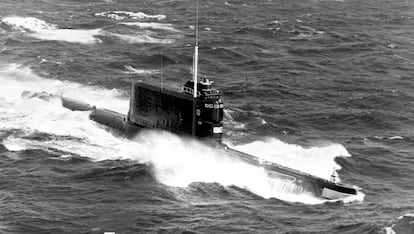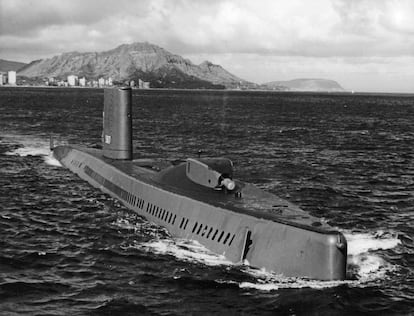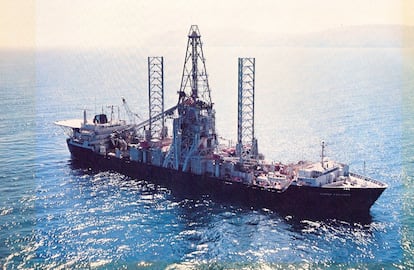The incredible story about how the CIA retrieved a Soviet submarine
Half a century ago, the U.S. agency succeeded in recovering the K-129, sunk at 5,000 meters, an achievement both from a technical point of view and for keeping the operation secret

In the early hours of March 11 and 12 of 1968, hydrophones located at the bottom of the Pacific Ocean detected two underwater explosions. They were able to establish the origins and cause: about two thousand kilometers southeast of the tip of the Kamchatka Peninsula, a submarine had just suffered a terrible catastrophe
It was a Soviet vessel called the K-129. It had left its base in Petropavlosk to go on a routine patrol. It was not a particularly modern submarine model, but it was loaded down with three one-megaton nuclear missiles – each one capable of destroying a city.
The Soviet Admiralty immediately sent rescue ships to the area where they estimated that the sinking had occurred, a move that alerted Western secret services. But the recovery operation was unsuccessful: the ocean in the area was almost 5,000 meters deep. After two months of unsuccessful attempts, the search was called off. The K-129 – along with its crew of 83 men – was considered lost, with the circumstances surrounding its destruction inconclusive.
The incident intrigued the US Navy enough to investigate what happened. Six months later, the USS Halibut was deployed to the area with the mission of locating and photographing the wreckage that should have been found in the position marked by the hydrophones.
The Halibut – formerly a nuclear-powered missile submarine – had been adapted to undertake “special operations” – a careful way of saying “espionage.” The missile launch ramp had been removed and reinforced with equipment no other submarine had: precision satellite targeting systems, state-of-the-art sonar, a Univac computer and a couple of cable-controlled scout pods. The pods were called “the fish” – each one weighed two tons and cost five million dollars.

For two months, the Halibut explored the area where the explosion had been detected, dragging a “fish” in search of the remains of K-129. It was not an easy operation. The robot had to fly just a few meters over the ocean floor, which required a towing cable that was several kilometers long.
The submarine was forced to maintain an extremely precise course and speed, lest its payload sink. To avoid obstacles, in total darkness, the “fish” had only the pulses that its sonar sent to the controllers of the Halibut. It also carried some cameras and spotlights for greater vision, but the beam only illuminated a limited area of the bottom. In that small rectangle of light, it was expected that the remains of the shipwreck would appear at some point.
The team recorded tens of thousands of photos of the ocean floor. The majority were abysmal, at most showing some clueless-looking fish. But finally, the effort paid off: one of the images showed part of a submarine’s turret.
A mosaic of several photos was assembled to achieve an overall view. It was K-129, split in two: the bow section was about a hundred feet long. The aft section, with the propulsion equipment, had landed a few dozen meters away. The part of the turret where the three vertical missile tubes should have been was damaged. One tube had disappeared, perhaps due to an explosion; the second seemed empty, but the third still had a seal that protected the missile. Inside the hull, encrypted transmitters and code books likely remained intact.
The CIA and Nixon
The American naval commanders discussed the possibility of opening a hole that would allow a robot to enter and perhaps recover some elements, but the idea was soon abandoned. The possible loot did not justify the cost and complexity of the operation. After all, the K-129 was an old submarine. In the three years since its sinking, much of its equipment – particularly its missiles – had become obsolete. But when the CIA learned of the discovery, its specialists conceived a much more daring plan: to recover the entire bow section of the submarine along with its contents, missile and torpedoes included. The idea reached the ears of Secretary of State Henry Kissinger and President Nixon. Both were enthusiastic and thus began an operation reminiscent of a spy novel.
The CIA commissioned the construction of a huge ship that would serve as a platform from which to raise the submarine to the surface. 180 meters in length, it was longer than a destroyer; its superstructure was crowned by a tower similar to those of oil well drillers. At the bow and stern, it had propellers embedded to allow for adjustments when it was anchored.

The project was classified as top secret. Since the construction of such a peculiar ship would not go unnoticed, a ruse was needed to hide its true mission. The CIA found someone they had branded as a trustworthy patriot to do the job: Howard Hughes, the paranoid millionaire, who lived in seclusion on the top floor of the Desert Inn in Las Vegas.
Hughes agreed to form a shell company dedicated to mineral exploration on the seabed. The ship would even bear his name: the Hughes Glomar Explorer. Officially, it was nothing more than a platform to collect manganese nodules from the bottom of the Pacific.
The CIA simultaneously contracted Lockheed Aircraft – a company with substantial experience in highly secretive projects, such as the construction of spy planes – to build an enormous claw, capable of grabbing the submarine and bringing it to the surface. The contraption would then be taken to the Glomar Explorer in a submersible barge, so that it could be installed without fear of prying eyes. The entire claw structure could tilt to compensate for sway. The system was inspired by the drills used in oil prospecting, although working at a depth of 5,000 meters had never been attempted before.
Russian suspicions
After almost four years of preparations, the Glomar Explorer was ready to carry out its work in the summer of 1974. But just as the operation was about to begin, the Glomar Explorer was spotted by a Soviet research vessel. Despite the fact that their ship was covered with antennae, the American officials explained that they were simply conducting underwater mining tests. The Soviet captain believed the story, even wishing them luck before departing.
Getting the claw to the ocean floor meant assembling more than five hundred sections of pipe. At six minutes per section – not accounting for inevitable setbacks – the operation took weeks. When the level of one thousand meters had been reached, a new visitor appeared: a Russian deep-sea tugboat, equally intrigued by the strange ship. But once again, the explanations were convincing. Even if the Soviets had launched divers, they would have only seen a long tube sinking into the depths of the water, conducting a perfectly innocent mining operation.
Claw weakness
Finally, the capture mechanism was placed exactly on the submarine. The claw closed its jaws around the submarine’s hull. Hydraulic pistons lifted it off the ground without straining the long hoist tube. Video and sonar cameras allowed the entire process to be followed from five kilometers above.
The slow ascent began. To lighten the load, the legs and pistons were abandoned on the seabed. It would take more than two days of effort as the ship creaked under the combined weight of the submarine and the lifting tube. Suddenly though, after two kilometers, part of the fastening nails gave way. The submarine’s hull, already greatly weakened by years of water damage, split in two. The larger section sank back into the depths, taking the missile bay with it. Upon hitting the bottom, it shattered into hundreds of unrecoverable pieces. Only a relatively minor piece remained in the jaws and was hoisted aboard.
An inspection of the submarine’s interior found some torpedoes, but no communication equipment or codebooks. At least, that’s the official CIA version.
The remains of six crew members were also found. On board the Glomar Explorer, a funeral was held according to Russian and American traditions before the bodies were returned to the sea. The ceremony was filmed by agency staff and handed over to Russian authorities years later. The film of the rest of the operation remains undisclosed.
The recovery of K-129, despite its failures, did have successes from a technical point of view. It was also carried out in the utmost secrecy… or, at least, it would have been, had there not been leaks to the press in March of 1975. Since then, there have been many attempts to uncover details about the operation, known under the code names of “Azorian” or “Project Jennifer.” Over the years, half-a-dozen books have been written based on interviews with those who oversaw the recovery of the submarine. The CIA has also published a very generic version… albeit with censored paragraphs.
Tu suscripción se está usando en otro dispositivo
¿Quieres añadir otro usuario a tu suscripción?
Si continúas leyendo en este dispositivo, no se podrá leer en el otro.
FlechaTu suscripción se está usando en otro dispositivo y solo puedes acceder a EL PAÍS desde un dispositivo a la vez.
Si quieres compartir tu cuenta, cambia tu suscripción a la modalidad Premium, así podrás añadir otro usuario. Cada uno accederá con su propia cuenta de email, lo que os permitirá personalizar vuestra experiencia en EL PAÍS.
¿Tienes una suscripción de empresa? Accede aquí para contratar más cuentas.
En el caso de no saber quién está usando tu cuenta, te recomendamos cambiar tu contraseña aquí.
Si decides continuar compartiendo tu cuenta, este mensaje se mostrará en tu dispositivo y en el de la otra persona que está usando tu cuenta de forma indefinida, afectando a tu experiencia de lectura. Puedes consultar aquí los términos y condiciones de la suscripción digital.
Últimas noticias
The complicated life of Francesca Albanese: A rising figure in Italy but barred from every bank by Trump’s sanctions
Half of Scotland is in the hands of 420 property owners
Pinochet’s victims grapple with José Antonio Kast’s rise in Chile
Reinhard Genzel, Nobel laureate in physics: ‘One-minute videos will never give you the truth’
Most viewed
- Pablo Escobar’s hippos: A serious environmental problem, 40 years on
- Why we lost the habit of sleeping in two segments and how that changed our sense of time
- Charles Dubouloz, mountaineering star, retires at 36 with a farewell tour inspired by Walter Bonatti
- Reinhard Genzel, Nobel laureate in physics: ‘One-minute videos will never give you the truth’
- The Florida Keys tourist paradise is besieged by immigration agents: ‘We’ve never seen anything like this’









































